Old Main: "That Noble Project"
That “Noble Project:” The Founding of Eastern Illinois University and the Origins of Old Main, 1895-1899
“Old Main” stands today as a tangible link to the past and present of Eastern Illinois University. The building's history and architecture embody the ideas, values, and personal visions of those who willed the university into existence in 1895, and the construction of Old Main as its first building in 1899. Those voices and visions became an enduring part of Eastern’s heritage, which we appropriately commemorate in 1999. The 100th anniversary of Old Main and the opening of classes at Eastern Illinois State Normal School (as EIU was originally known) is indeed an occasion for substantive reflection. Eastern’s mission and identity have changed dramatically over the years, yet withal we have continued to build on time-honored traditions. As Eastern has grown into the regional university of today, it continues to draw strength from its past. Each generation of faculty and students who have taught and attended EIU has added to that experience and left its signature in history.
Today the faculty and students of Eastern Illinois University are poised at the end of one millennium and the beginning of another. It is important that we look backwards as well as forwards on this occasion, and that we reaffirm as scholars, teachers, and students that we are stewards of intellectual traditions and a collective experience that predate us and will succeed us. Our associations with Eastern have connected us individually and collectively to something larger than ourselves—the experiences of earlier generations who once taught and studied here. As the student editors of the 1975 Warbler mused, “The combination of the buildings, the people, the events, and the experiences is what makes EIU. No one aspect stands alone as the single definition of Eastern; they all fit together to form a complex, indescribable part of life that will not be forgotten. Regardless of whether you like it or not, your are a part of Eastern. The question is, is Eastern a part of you?”1 For those entrusted with nurturing the university and with keeping its history fresh and alive, the answer to that question is a resounding yes. It is well met that we commemorate the centennial of Old Main and the arrival of Eastern’s second century with a backward glance.
Few occurrences tell us more about the aspirations and self perceptions of a community than its efforts to become a county seat, a state capital, or the seat of a college or university. That is certainly true of the histories of Charleston and Mattoon, Illinois, and their quests to become the site of a state normal school in 1895. Indeed, much of the rivalry between these two communities stems from the contest to become the seat of Illinois State Normal School. The Charleston-Mattoon rivalry preceded that event and would have continued for other reasons, as local rivalries do, had the normal school been established elsewhere in east-central Illinois. But the fact that the denizens of Mattoon had spearheaded the movement for a normal school in Coles County only to have the prize go to Charleston in the twelfth hour has become part of the oral traditions of those communities, and ensured that their rivalry would continue apace.
Yet the coming of a state normal school to eastern Illinois was far more significant an event than the contest between Charleston and Mattoon. The effort to lobby the state legislature and to organize support for the movement in both communities represents an important episode in the intellectual and cultural history of Illinois. Normal schools originated and evolved within a specific vision, and embraced certain social values that both transcended and defined the places where they were established. Although normal schools were not without their critics, the value of those established at Normal, Illinois in 1857 and at Carbondale in 1869 were generally proclaimed by the Illinois educational establishment and politicians alike. The founding of Eastern Illinois State Normal School at Charleston in 1895 was the localized version of a national movement, and the history of Eastern fits the broader pattern in which Midwestern normal schools and those in other regions of the United States were established. There were significant local variations and nuances to be sure, but the normal school movement played a major role in the education of the republic throughout most of the nineteenth, and its influences continued to be felt in the early twentieth century.2
If the educational system of Illinois was the “fine mother of our stoutest virtues,” as Illinois Senator T. V. Smith once called it, then normal schools were her handmaidens. Their mission was to train the residents of their region to educate their own. Normal schools prepared students intellectually and socially for the rigors of teaching in township schools and city school districts, be they one-room school houses like the Greenwood School or the local school districts of Charleston and Mattoon. Normal schools were to normalize the teacher-training process, inculcate prescriptive social values, and impart skills for the classroom. Normals embraced a core set of values regarding useful and practical learning, and were exponents of a democratic culture and a populist vision of teacher training.
The chain of events leading to the establishment of Eastern in 1895 dates to a committee report of the Illinois Senate in 1887, which recommended the establishment of additional normal schools in the state of Illinois. Only two such institutions existed in Illinois at the time (those at Normal and Carbondale), while neighboring states were forging ahead with the normal school movement at the expense and embarrassment, it was argued, of Illinois. Missouri already had three normal schools, Minnesota four, and Wisconsin five. The Illinois Teachers Association recognized the need for more normal schools in the state during its annual meeting at Springfield in 1892, creating a normal school committee of seven. Some of those members expressed the opinion at the 1893 state meeting that Illinois would benefit from the establishment of three to five more normal schools in different parts of the state. It was manifestly obvious to those residing in the eastern counties of Illinois that they could benefit from a normal school, and that their educational needs were just as critical as those in other area of the state.
Two years later the movement for a normal school in eastern Illinois began with a group of local boosters at Mattoon, Illinois. Their efforts would ultimately be successful, but events would unfold in a way that they neither envisioned nor controlled. The first step was taken when John L. Whinsard, Superintendent of Schools in Coles County, appointed Dr. J. T. Montgomery of Charleston, C. E. Watson of Mattoon, and Eli Dudley of Ashmore to a committee charged with investigating the expediency of a normal school in Coles County.3 Interest in the idea continued at a county teachers meeting held at Mattoon on January 26, 1895, where Professor Charles A. McMurray of Illinois State Normal School discussed the need for more normal schools in the state and that Mattoon was well situated for such a school. His suggestion was well heeded, for on February 2nd B. F. Armitage, the Mattoon Superintendent of Schools, C. T. Feagan, former County Superintendent, and John F. Scott, a Mattoon lawyer, called a meeting in the chambers of city council to promote the idea of a state normal school in Mattoon. A committee of five was appointed to push the matter with the legislature, consisting of L. L. Lehman, Scott, J. H. Clark, C. E. Wilson, and J. J. Beall—what the Mattoon Weekly Gazette described as a “committee of hustlers.”4 The hustlers moved with dispatch, contacting the Coles County members of the Illinois General Assembly.
Educators, legislators, and community leaders in Mattoon forged an alliance to lobby for legislation that would establish a new state normal school in eastern Illinois. On February 7, 1895, Senator Isaac B. Craig of Mattoon and Representative W. H. Wallace of nearby Humboldt introduced bills in their respective houses for the school’s establishment.5 On May 22nd of that year, Governor John Peter Altgeld (1847-1902) signed the act of the Illinois General Assembly which appropriated $50,000 for the establishment of Eastern Illinois State Normal School.6 The act stipulated that the object of the new school “Shall be to qualify teachers for the common schools of this State by imparting instruction in the art of teaching in all branches of study which pertain to a common school education, in the elements of the natural and the physical sciences, in the fundamental laws of the United States and of the State of Illinois, in regard to the rights and duties of citizens.” The mission of the new school was clear enough, but its location in eastern Illinois was left undecided. That would be the job of the five-member Board of Trustees of Eastern Illinois Normal School which had also been established by the legislative act of May 22nd.
The contest to become the seat of the new normal school began immediately. Mattoon, Paris, Danville, Shelbyville, Effingham, Kansas, Olney, Oakland, Palestine, Lawrenceville, Tuscola, and Charleston all vied for the honor and the economic and cultural opportunities that the school would bring into their midst. Mattoon had clearly seized the initiative and had every reason to believe that it would become the seat of the normal school and not its nearest competitor, Charleston. The Mattoon initiative began earlier than Charleston’s and it had a population of some 9,622 compared to Charleston’s 5,488.7 Mattoon sat astride rail lines that ran north-south and east-west, while Charleston was serviced by an east-west line only. [Fig. 1] State Senator Isaac B. Craig of Mattoon was a member of Governor Altgeld’s own political party, and it was Craig who introduced legislation in the Illinois Senate for the establishment of a normal school in eastern Illinois. The economic and political dimensions of the situation seemed clearly to favor Mattoon. The Mattoon Weekly Gazette exhorted the community to get behind the idea, reassuring its readers that if the matter was pushed insistently “there is every opportunity of winning.”8 The location of the school in Mattoon would be an economic boon to everyone and worthy of the attention of those who could afford to contribute something to “the noble project” at hand.9
That noble project continued in Mattoon for many more months, but in the end it was Charleston that carried the day. The first call to action in Charleston came from the Charleston Commercial Club, which met on April 18, 1895 to the discuss the prospects of having a normal school in Charleston. The following evening J. W. Henninger, Superintendent of the Charleston Schools, chaired a public meeting which appointed a Normal School Committee that eventually numbered eight members. It included R. S. Hodgen, a real estate dealer; Mayor W. R. Patton; George H. Jeffries, another real estate dealer; and Henry A. Neal, an attorney and committee chair.10 The Charleston Normal School committee raised $75,000 in pledges for attracting the normal school to Charleston.11 The contest with Mattoon had been enjoined and would be promoted vigorously through Charleston’s daily and weekly newspapers.
The Charleston Scimitar, for example, called attention to the importance of securing a normal school and urged prompt and vigorous action in the matter. An editorial of May 24, 1895 was aimed squarely at those in Charleston who seemed indifferent as to whether the school went to Mattoon or to Charleston.
THOSE few people in this city—fortunately there are VERY few of the them—who are saying that they would just as soon that Mattoon should have the Normal school, as Charleston, are very, very foolish, especially if they are property holders in this city. Don’t you know, Mr. Citizen, that if Mattoon gets that Normal school, property in this city can reasonably be expected to depreciate fully twenty-five per cent, and that the balance of population . . . will immediately set toward the city on the west side of the county and Charleston will be left high and dry on the strand of blasted ambition.
Material interests were clearly involved in the contest and Mattoon’s lead was disconcerting to boosters in Charleston. The Scimitar did not hesitate in saying “that it would be the worst possible business catastrophy [sic] that could happen to Charleston” should the Normal School be located in Mattoon.12
Charleston entered the competition for the new normal school in dead earnest when it presented a comprehensive proposal to the Board of Trustees. If the normal school was located within two miles of the Coles County courthouse in Charleston, the city would donate 40 acres of land and donate $35,000 to $45,000 dollars to the school, depending upon the value of the site selected; run city water to the site, provide at least four fire hydrants, and supply the school with water for fifty years at five dollars a year; pave or gravel a street from the courthouse to the edge of campus, and provide adequate sidewalks; furnish incandescent electric lights to the school for twenty five years at the rate of ten cents per thousand watts and at half the regular rate for arch lights (a true bargain); provide up to $5,000 dollars worth of freight to the school on any of the rail lines of the Cleveland, Cincinnati, St. Louis, and Chicago Railway Companies; provide free freight on the rail line of the Toledo, St. Louis, and Kansas City Railway Companies for materials used in the construction of buildings; provide the school with various grades of coal for heating at fixed rates until July 1, 1901; and furnish all gravel needed for walkways, roads, and driveways on school grounds, and bring them free of charge to Charleston.13
|
That offer would out distance all competitors. Charleston was selected as the site of Eastern Illinois State Normal School on September 7, 1895, and from that day forward the histories of Charleston and Eastern were inextricably entwined. Charlestonians received the news in a telegram from George H. Jeffries, a member of Charleston’s Normal School Committee, who was lobbying at the statehouse in Springfield when the Board of Trustees made their final decision: “To the People of Charleston: Charleston wins on the twelfth ballot. Hard fought battle. Be home tonight.”14 [Fig. 2] Celebrants greeted the returning Jeffries contingent at the Charleston depot at 11:30 that night, escorting them to the town square where they cheered their victory in an exuberant celebration that lasted until well after midnight. The more perceptive of the celebrants at Charleston realized that the coming of the new Normal School would change their community significantly. As Henry A. Neal, a member of Charleston’s Normal School committee observed, “It’s the turning point in the history of our city.”15 [Fig. 3] |
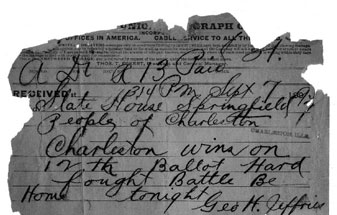 Fig. 2. George H. Jeffries' Telegram, September 7, 1895. George H. Jeffries, a real estate agent and a member of Charleston's Normal School Committee, sent this telegram from Springfield when the Board of Trustees made their final decision on the site of the new normal school: "To the People of Charleston: Charleston wins on the twelfth ballot. Hard fought battle. Be home tonight."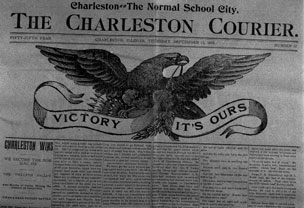 Fig. 3. "Charleston, The Normal School City," Charleston Courier (September 12, 1896). The banner headline, "Victory[,] Its Ours," informed Charlestonians that they had won the contest to be the site of the new normal school. |
The reaction in Mattoon was somewhat different, where the headline of the Mattoon Weekly Gazette derisively proclaimed: “Charleston Gets It. The New Reform School Located at Catfishville.”16 The citizens of Mattoon were stunned and angry. According to the Charleston Courier, a great amount of labor was lost in Mattoon’s preparations to celebrate the location of the normal school in that city. “The newspapers had it all written up for the occasion, with spread eagles, roosters, and flags lavishingly [sic] displayed, great headlines heralding the many qualities of the coming [new] Chicago.” Instead of preparing to glory in their wonderful achievement “they had better been engaged in making a monster coffin in which to bury their wrath.” That wrath soon expressed itself in a petition to the State Attorney at Springfield for a writ of quo warranto. The proceedings challenged the authority of Samuel M. Inglis, State Superintendent of Public Instruction, to act as a trustee of Eastern Illinois State Normal School and to vote on the selection of the site. Bribery was also charged.17 The Charleston Courier regarded the action as a personal insult to Charleston and spoke contemptuously of the editor of the Mattoon Gazette (who had allegedly insulted the trustees) as “a dirty cur.”18
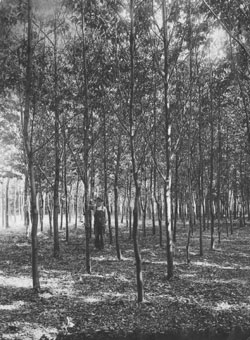 Fig. 4. Bishop's Wood, ca. 1925. The original forty acre site of the Eastern Illinois State Normal School was purchased from Virginia M. and Charles E. Bishop on September 14, 1895 for $3,000. |
The contest between Charleston and Mattoon for the location of the Normal School had been a plucky and determined one in which local pride, boosterism, and hyperbole played their part. Months of incessant labor had “strained every nerve and exerted every possible influence, political or otherwise” among the all communities that had vied for the honor being chosen,19 but most especially in Charleston and Mattoon. Nothing ever came of the quo warranto proceedings, which would have had to overturn the unanimous vote of the trustees in selecting Charleston in order to have been successful. There was little time for such an annoyance anyway, for the city of Charleston moved quickly and confidently to make good its promise to support the normal school it had worked so diligently to secure. On September 9, 1895 (only two days after announcing the location of the Normal School), the trustees visited Charleston and selected the actual site of the school—a forty-acre tract of land lying about three quarter of a mile south of the center of Charleston, and roughly equidistant from the Normal Schools at Bloomington and Carbondale. The land was purchased from Virginia M. and Charles E. Bishop on September 24th for $3,000.20 [Fig. 4] |
Plans for transforming “Bishop’s Woods” into the grounds of Eastern Illinois State Normal School began immediately. The trustees contracted the services of the Indianapolis architectural firm of McPherson and Bowman to design the first building, accepting their plan on October 5, 1895. The plans were not to the liking of Governor Altgeld, who appears to have had his own ideas of how a normal school should look. Altgeld insisted that the trustees abrogate their contract with McPherson and Bowman. The firm came up with a new plan which was ultimately rejected in favor of another design by the Bloomington architect, George H. Miller. Miller made alterations and modifications to the original design scheme of McPherson and Bowman. Bedford limestone from Indiana would now be used in the construction of the building instead of “Ambraw stone” quarried locally as called for in the original plan.21 It is Miller’s name that appears on the granite cornerstone of Old Main as the supervising architect, but other architects and contractors would play a significant role in shaping the building that gradually rose from Bishop’s Woods.
|
The $86,000 contract for the construction of the Normal School Building, as Old Main was first known, went to the Chicago firm of Angus and Gindele on December 12, 1895. The superintendent of Angus and Gindele, F. W. Watts, and the construction foreman, G. F. Auld, arrived at the site on March 24, 1896. The building was lined out and excavation commenced on the 25th, with the first stone of the brick and limestone edifice being laid on April 11th.22 Altgeld is usually credited with having influenced the final appearance of Old Main, as well as a number of other public buildings designed and constructed during his tenure as governor from 1893 to 1897. There is no doubt that he took a personal interest in the construction of these buildings, and that he attempted to have his views on architecture reflected in them. [Fig. 5] |
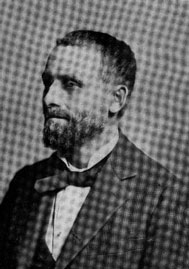 Fig. 5. Governor John Peter Altgeld (1847-1902). Governor Altgeld signed the act of the Illinois General Assembly which appropriated $50,000 of the establishment of Eastern Illinois State Normal School. Altgeld promoted the Gothic revival styles found on several Illinois campuses, including Eastern's Old Main. How directly he was involved in the design of Old Main, however, remains uncertain. (Illinois State Historical Library). |
Altgeld expressed those views in his second biennial message to the Illinois legislature. He believed that too little consideration had been given to matters of architectural design in the construction of Illinois’ public buildings. Aesthetics should be a primary consideration, for the exterior of public institutions should be “commanding” or “impressive.” Legislative appropriations should be made for ornamenting their exteriors as well as for making them spacious and fireproof.
After an examination of the subject I became satisfied that the most inexpensive, as well as the most impressive architectural style of buildings that are to stand alone in a grove, or in a field, is what has been called the Tudor-Gothic style, as the effect is produced by simply carrying the mason work, that is the wall, above the cornice line, and there breaking the lines in such a way as to produce small towers, battlements, etc. This style has consequently been adopted in most of the buildings that have been erected in the last two years, and is found to be very effective. Had we possessed large appropriations so that Grecian columns, Roman arches, and other forms of ornamentation could have been indulged in, it is probable that some other style of architecture would have been selected; but for the money which the State has expended it would have been impossible to get the same desirable effects in any other style.23
Aesthetics, education, politics, and money all informed the context in which Old Main and other public buildings of its era were designed and constructed. Altgeld believed that the style of architecture he identified as “Tudor-Gothic” provided the most cost efficient means then available to provide the state with appropriately imposing and edifying buildings. What is perhaps the clearest expression of his views on the subject were made in a speech given at the laying of the cornerstone of the Rock Island hospital for the insane in the fall of 1896.
You have observed that the style of architecture adopted is what has been called Tudor-Gothic and has something in common with some of the famous castles found in Europe. I am told that as a traveller ascends the Rhine and views some noted castle situated on a hill-top he is regaled with an account of the marauding baron who lived there centuries ago and with a small band of retainers emerged from time to time to rob and plunder his weaker neighbors. In the centuries which are to come, as the intelligent traveller shall ascend the great Father of Waters [the Mississippi] and see this magnificent structure commanding a view of the surrounding country, he will exclaim: “There stands a monument to the intelligence, the civilization and the humanity of the people of northwestern Illinois.”24
The same can be said of the architecture of Old Main, for clearly its picturesque towers and battlements were intended to evoke the same historical associations and to serve the same edifying purpose. As one of Altgeld’s biographers has noted, “A few survivals of what came to be known in Illinois as the ‘Altgeld style of architecture’ are still to be found in that State.”25 Altgeld Hall at Northern Illinois University, Cook Hall at Illinois State University, and Old Main at Eastern Illinois University are all, in a popular sense, Altgeld’s castles. One still occasionally hears them referred to as such when visiting those campuses. But the popularity of the Gothic-revival style on American campuses at the close of the nineteenth century urges caution lest we attribute too much credit to Altgeld. He was embracing an architectural style that appealed to many of his contemporaries as well. The Gothic-revival style of Old Main was part of a larger architectural movement that embraced many public buildings.
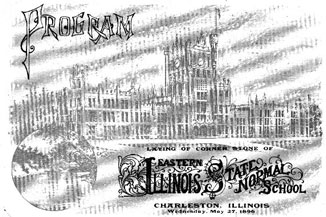 Fig. 6. Program for the Corner Stone Ceremonies, May 27, 1896. The crowd attending the corner stone ceremonies reportedly numbered 15,000. The proceedings were conducted under the auspices of the Grand Lodge of Masons of Illinois, with all their rights and ceremonies. Governor Altgeld gave the oration of the day, speaking on the educational advantages which the Normal School was certain to bring to Illinois and the city of Charleston. |
Whatever Altgeld’s role in the actual design of Old Main was or was not, there is no question that he approved of the structure that gradually arose from Bishop’s Woods. On May 27, 1896, he participated in laying of the granite cornerstone at the northeast corner of the building before an approving crowd that reportedly numbered 15,000. The proceedings were conducted under the auspices of the Grand Lodge of Masons of Illinois, with all their rights and ceremonies. Combined bands from Sullivan, Mattoon, Shelbyville, and Charleston began and closed the ceremonies, which were punctuated throughout with songs by a Shelbyville glee club. Addresses of welcome were extended by H. A. Neal, Mayor of Charleston, and F. M. Youngbood, President of the Board of Trustees of Eastern Illinois State Normal School, while formal addresses were delivered by State Senator I. B. Craig of Mattoon and Samuel M. Inglis, State Superintendent of Public Instruction and a trustee of the Normal School. Governor Altgeld gave the oration of the day, speaking of the educational advantages which the Normal School was certain to bring to Illinois and the city of Charleston.26 [Fig. 6] |
The founding of an institution marks an upward step of the people. It marks a forward stride by the state and it marks an era on the tablets of time. Our people have now set themselves to founding on the highest plane and building for all time, those educational institutions which shall mould [sic] the intellect and shape the character of the youth for all generations to come. . . . To-day we lay the corner stone of an institution that shall train teachers, . . .My fellow citizens, the character of the institution will depend upon the people who surround it. It will be what you make it. . . . The responsibility is upon you to see that only learning, ability, character, and superior merit shall secure any connection with this university, . . . With the hope and with the belief that this university shall shed luster over our land through the centuries that are to come, we dedicated it to posterity.27
Among the items enclosed in the cornerstone was an invitation to the cornerstone ceremony, the program of activities for the day (which included an engraving of the original architectural conception of Old Main), a copy of the legislation establishing the school, the signatures of the governor and the first board of trustees, and those of some of the architects and contractors who had raised the magnificent building amidst the trees of Bishop’s Woods.28 The Mayor of Charleston, Henry A. Neal, characterized the laying of the cornerstone as “a red letter day in Charleston history.” Charleston had donated $56,216.72 to the Normal School,29 but Neal believed it would prove of greater benefit to the community than even its warmest supporters had realized. Charleston from that day forward was entering into a new and unprecedented era of prosperity. “On this 27th of May, the spirit of improvement has seized upon our people, . . . and everybody has faith in our future. Hoping that thousands of efficient teachers may go forth from the School to better the schools of our state, we deposit this paper with the best wishes of the City of Charleston for the success of this institution.”30
Another Charlestonian, John Auld, shared the sense of fulfillment and patriotic fervor that attended the laying of the cornerstone, which he memorialized in the Charleston Courier with the following lines.
The long expected day has come,
The time of waiting gone
And preparations are complete
For the laying of the stone.
And Charleston has adorned herself
With drappings rich and rare
Of varied hue—red, white, and blue,
The nation’s pride and care. . . .Transformed from all the cares of life
Man’s heir and Heaven’s rule,
They come to manifest their love
For Charleston’s Normal SchoolAnd witness the proceedings which
Shall mark this day of grace
And hand it down for time to come
To their successor race. . . .They gather round the sacred spot,
Upon the Normal base,
And hear the worlds of intellect,
Which time can not erase.And see the stone set on its base
By true Masonic skill,
Conform to plummet, square and rule,
Their minds with wonder fill.And then in glare of flying fire,
Against the azure blue,
The record read that Charleston has
Fulfilled her promise true.31
|
Further work on the Normal School Building came to a grinding halt in the fall of 1897, when the firm of Angus and Gindele became “financially embarrassed” due to the failure of the Illinois National Bank of Chicago. The firm forfeited the contract after having received $69, 826.74 for their services.32 Under Angus and Gindele, the walls had been raised and were nearly ready for the installation of the roof. An appropriation of $75,000 was made by the legislature in May of 1897 and a contract for $14,000 drawn with Alexander Briggs (1855-1924),33 a Charleston stonemason and contractor, to complete the abandoned contract of Angus and Gindele. Another contract of $59,959 to complete the building was made with the Charleston firm of Briggs and Fuller on September 7, 1897. [Fig. 7] The trustees hired Charles Ward Rapp of Chicago as the supervising architect and John Voss of Peoria as superintendent of construction under Briggs and Fuller.34 It was during this final stage of construction that Charleston made good its earlier pledge to connect the town to the grounds of the school, authorizing the paving of a street from the railroad tracks to Lincoln Street. Sixth Street (formerly Jackson Street) ended directly in front of the Normal School Building and in time became a new corridor of growth for Charleston. Gradually, part of the community would reorient itself toward the Normal School. The “Bishop’s Heights” addition, for example, was being promoted even before the Normal School Building had been completed. [Fig. 8] |
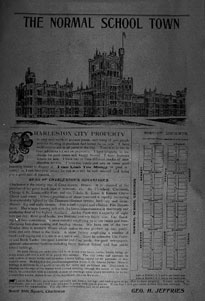 Fig. 8. "The Normal School Town," Charleston Daily Courier (May 26, 1896). Charleston real estate agent George H. Jeffries promoted "Bishop's Heights[,] the Normal School Addition to Charleston" adjacent to the Normal School Ground. Jeffries had been a member of Charleston's Normal School Committee in 1895. |
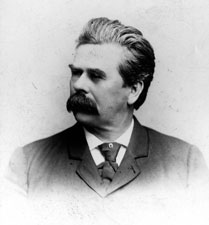 Fig. 9. Samuel P. Inglis (1841-1898). Samuel P. Inglis of Greenville, Illinois, State Superintendent of Public Instruction, was hired as the president of Eastern Illinois State Normal School in April of 1898, but died before assuming office.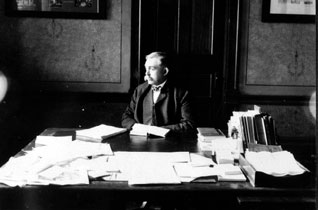 Fig. 10. Livingston Chester Lord (1851-1933) at his desk in Old Main, ca. 1899. Lord was previously the president of Moorehead Normal School in Minnesota. The photograph of Lord at his desk is believed to have been taken shortly after the commencement of classes in September of 1899. |
By December of 1898, the Normal School Building was essentially complete and ready for furnishing. The frescoing and installation of electrical fixtures and telephones was all that remained to be done. “We believe we have a first class building in every respect; that no brick, stone, or piece of building material of any kind unfit to be in the building can be found therein, and that all the work was done in a first class manner.”35 As of yet, however, the Normal School had neither a president nor a faculty. The Board of Trustees chose Samuel M. Inglis (1841-1898) of Greenville, Illinois as Eastern’s first president on April 12, 1898. Inglis, the State Superintendent of Public Instruction and a trustee of Eastern Illinois State Normal School, had been a major supporter of normal schools in Illinois and among those who voted to locate Eastern Illinois State Normal School in Charleston. Inglis accepted the position but died on June 1st before assuming office. [Fig. 9] It was Inglis’ successor who would shape the first faculty at Eastern and much of its destiny in the process. On December 8, 1898, the trustees selected Livingston Chester Lord (1851-1933) as the new president of Eastern Illinois State Normal School. Lord had been president of Moorehead Normal School in Minnesota for the previous ten years. [Fig. 10] |
The event that heralded Eastern’s eminent arrival was the formal dedication of the Normal School Building on August 29, 1899. The Charleston Daily Plaindealer declared that “This is the day of days with Charleston. It consummates a great triumph. It opens a new era in her history. It marks an epoch in this section of the great commonwealth of Illinois.”36 Imposing and impressive ceremonies attended the dedication, including “A Great Throng” variously estimated at 25,000 to 30,000 celebrants.37 The building we have affectionately come to know as “Old Main” (officially the Livingston C. Lord Administration Building) differed significantly from the architectural design depicted on the program of the 1896 cornerstone ceremony and in the Charleston City Directory for 1898-1899. That was a far more elaborate structure than the one actually built, although the two designs have an elemental affinity between them. Even so, the castle at Bishop’s Woods was an edifying structure.
|
Excursionists from Mattoon, Paris, and Peroria came to Charleston in order to admire the finished structure and to participate in the festivities attending its dedication. Crowds made their way along Sixth and Seventh Streets to the dedication ceremony and participated in the dedication parade at Sixth and Harrison Streets. [Fig. 11] The presence of the Mattoon contingent was particularly appreciated by the Charleston Daily Courier. “Mattoon did nobly yesterday and our citizens were delighted in consequence. It is estimated that our neighbor sent fully 8,000 of her residents to participate in and attend the day’s exercises. . . . Charleston has absolutely no cause to complain of Mattoon’s interest in the Normal and the occasion of its dedication.”38 Indeed, it did not. Mattoon’s “noble project” had become Charleston’s noble prize. The decision of the trustees to award the Normal School to Charleston instead of Mattoon was eventually forgiven, but never forgotten. Although the healing process was already underway by the time of the buildings dedication, the charge of foul play and a corrupt bargain continued in the oral traditions of the two communities down to the present day. |
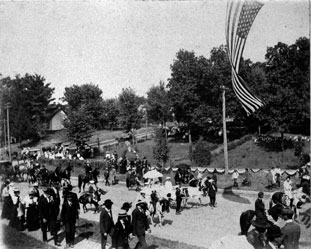 Fig. 11. Dedication Day Parade, August 29, 1899. Crowds made their way from the Charleston Courthouse to the dedication ceremony at the Normal School Building along Sixth and Seventh Streets, and participated in the dedication parade. |
Governor John Riley Tanner participated in the parade and the dedication ceremony, along with the Normal School’s new president, Livingston Chester Lord. The dedication ceremonies fulfilled long-standing aspirations and promised future benefits for the teachers and students of eastern Illinois.39 Those in attendance listened attentively as Lord simply but effectively stated what the new school aspired to be and do. “I want this school to cause its pupils to teach, in turn, their pupils to think, to move, to be obedient, and to be patriotic.”40 As a society we are far more ambivalent today about the role of patriotism in the public schools, or what might be perceived as indoctrination of any kind, than we were at the close of the nineteenth century. At Normal schools the teaching of patriotism—America’s civil or secular religion—was a prime directive. It was inextricably interwoven into teaching the fundamental laws of the state and the nation, and the rights and duties of teachers and students as American citizens. Patriotic fervor was particularly acute in 1899, however, as the United States was then embroiled in the Spanish-American War.
The most important address given during the dedication of Eastern Illinois State Normal School was that delivered by Dr. Richard Edwards (1822-1908) of Bloomington. Edwards had been president of the Illinois State Normal University at Normal from 1862 to 1875 and State Superintendent of Public Instruction from 1887 to 1891. He spoke with great passion and eloquence on the origin, progress, and mission of the American Normal School. Edwards drew attention to important considerations in the history of normal schools in the United States, their value to society, and how they should be managed. Teacher training, like other forms of higher learning, aimed at imparting knowledge, but especially concerned itself with shaping the character of those who by precept and example would shape the character of others. The fundamental maxim of normal schools, said Edwards, should always be that “Character is the most powerful molder of character.”
Moreover, the normal school idea was decidedly a populist conception. Normal schools were to prepare teachers to educate the masses, and not just a particular class of people. Normals were called into existence to ensure that public education rested firmly upon democratic values.
There was danger that by the prevailing systems of education the people would be divided into classes whose interests would clash. There was danger that an aristocracy would be developed. There was danger that the masses of the people would be relegated into a position of inferiority. There was danger that the power conferred by culture would be used to exalt the few at the expense of the many. It is not too much to say that the normal school idea, and the normal school as an institution, have been potent factors in removing this danger. Indeed, among the influences that have tended to make education universal in the United States, it clearly seems that the normal school stands foremost.41
The ends of normal schools were further reflected in the characteristic manner in which they were organized and managed. Of this idea, Edwards strongly approved. Everything should be arranged around the systematic study of the methods of teaching, their underlying principles, and their application in Model or Practice Schools. This was the field of activity where the great and important work of normal schools was done. The practical or applied nature of the normal school curriculum was its most distinguishing feature, where educational theory was always submitted to the test of professional practice. The instructional principles and methods which normal schools imparted to their students were directed at actual conditions existing in public schools. Normal schools were to be engaged in their communities and not just with their students and faculty. They existed in order to illustrate the best methods of instruction in the ordinary branches of learning, but in a manner that linked theory and practice into every step of the learning process.
It is a universally accepted principle that general principles can only be thoroughly taught by being practically applied. Our views of general truths are filmy. The effort practically to apply them helps our conception of them wonderfully. This is really the basis for the establishment of practice schools. The normal student in his normal class may be led to see the value of a process in instruction, and the soundness of the principle on which it is based. And yet his knowledge of the subject may be vague. Only practice can make that knowledge thoroughly reliable.42
Edwards concluded his dedication address with an elaboration of the mission of Eastern Illinois State Normal School and its responsibility to the people of its region. A more complete statement of the original purpose of Eastern is not wanted. The ideas and values embodied in his words would be recapitulated in the annual catalogues of Eastern Illinois State Normal School for years to come. The force of Edwards’ convictions and the power of his sentiments can still be felt a full century later.
And let it be remembered that the normal school is, in a peculiar sense, for the use of the whole people. . . . It is not to be the instructor of a class, nor of children of a class. It is the culminating achievement of universal education. . . . And the idea of universal education has at its basis the great principle of human equality. Let the teacher go forth from the normal school fully inspired with this grand idea. Let him say to himself in serious earnestness that his business is the elevation, intellectually and morally, of the entire community. . . . No higher service can be rendered to humanity than that which is rendered by the true teacher. And this must be rendered to all without favoritism or undue discrimination. . . . The teachers that go forth from these halls will have such duties to perform as will make the right kind of characters an essential element in their work. The normal school is not here merely to furnish information, which may be used for good or for evil. It is here to furnish, as far as possible, true ideas of living. It is here for the purpose of molding souls whose characteristics shall be fit to be reproduced in those that come under their charge. I do not mean to say that a large amount of time shall be devoted to the enforcement among pupils of right conduct. Not that. But there must be in the institution an ethical energy that shall make itself felt for the good. I think the institution ought to hold itself responsible for this. If there is any place on earth where the highest ideals of character should be insisted upon, it is in the normal school. The very essence of a normal school is that it is a fountain from which streams of influence shall go forth. . . . Go forth, inspired by the thought that it is possible for your here to do the grandest work for humanity which is ever permitted to human energy.43
|
Classes began at Eastern Illinois State Normal School on September 12, 1899 with a faculty of 18 and a student body of approximately 125.44 The first graduating class of 1900 consisted of four students, one woman and three men. [Fig. 12] Lord remained at the helm of Eastern until 1933, leaving an indelible imprint upon the schools’ early culture. Eastern remained a normal school for twenty-two years, conscientiously and scrupulously preparing elementary and secondary teachers for Illinois schools. The school did not then offer bachelor’s degrees, but qualified individuals to teach after completing a varied course of study and served as a laboratory for future teachers. Charleston children, for example, could attend Eastern’s Model or Practice Schools run by experienced “critic teachers” and “practice teachers” (students). The Model School was originally located in Old Main, but moved to the Training School Building which was constructed in 1913 and renamed Blair Hall in 1958. [Figs. 13 & 14] The Model Schools were the forerunner of the later “lab” school attended by the children of Charleston residents and university faculty. |
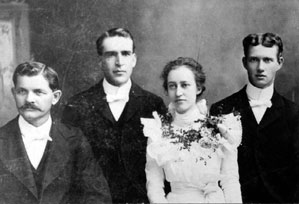 Fig. 12. First Graduating Class of Eastern Illinois State Normal School, Class of 1900. From left to right: Marion Nelson Beeman (Robinson), Lloyd Goble (Westfield), Guy Jink Koons (Oakland), and Bertha Volentine (New Douglas).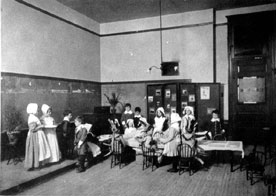 Fig. 13. Role Playing in the Second Grade of the Model School, Second Floor of Old Main 1912. The Model School moved to the new Training School Building in 1913, which became Blair Hall.
|
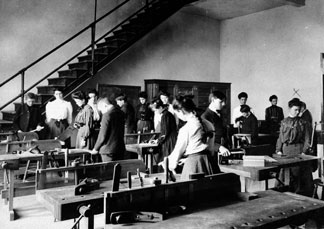 Fig. 14. Manual Training Class, Model School, Third Floor of Old Main, 1912. The stairs in the background lead to the tower. Fig. 15 Graduating Class of Eastern Illinois State Normal School, ca. 1916. Standing in the background are Eastern's first Geenhouse (1903) center, the back of Old Main (1899) center, Pemberton Hall (1909) left, and the Training School Building (1913) right--renamed Blair Hall in 1953. The smoke stack rises from Eastern's original powerhouse (1899) which was located directly behind Old Main. (Alumni Association, Eastern Illinois University)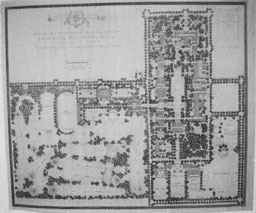 Fig. 16. Chance S. Hill, "A General Plan Showing Design for Campus of Eastern Illinois State Teachers College, Charleston, Illinois, December 16, 1944." C. Herrick Hammond, Supervising Architect, State of Illinois. Charles S. Hill, a landscape architect in Oak Park, Illinois, prepared this plan as a guide for a twenty-five year building program. |
Eastern’s last year as a normal school was 1921, when the school boasted 1,667 students and a faculty of 44. [Fig. 15] But changes were already afoot as Eastern Illinois State Normal School became Eastern Illinois State Teachers College that same year, offering a four-year bachelor’s degree for the first time in its history. It remained a state teacher’s college until 1947 when it became Eastern Illinois State College, which now also offered non-teaching bachelor degrees.45 Another change in name and mission occurred in 1957, when Eastern Illinois State College became Eastern Illinois University. By the 1973-’74 school year, the faculty had grown to nearly 600, the student body to 8,000, and the campus had expanded dramatically. [Fig. 16] Growth remained a hallmark of the Eastern experience over the next quarter century. The student body increased to more than 10,000 students and the curriculum broadened in response to societal change. As Eastern’s president Gilbert Courtland Fite observed of those changes in 1974, “As an institution we draw strength from our history and traditions, but must not be bound by them. The needs of students change as society changes.”46 |
Teacher training remains an essential part of Eastern’s mission, but today its success is also measured by the expanded number of degree offerings both within and without the field of education. Eastern has emerged as a comprehensive university. But we may still take pardonable pride in the sense of purpose and public service that originally called the university into existence. As the trustees of Eastern Illinois State Normal School noted in 1898, “. . . no expenditure brings so large a return as money expended for education. Our public schools and our normal schools are of immediate and direct benefit to the State and should receive a liberal support. While primarily the duty of educating the child devolves upon the parent, secondarily it is upon the State, as the ignorance of one endangers all.”47 That was the educational vision of those who founded Eastern Illinois State Normal School, and teaching teachers was prime directive:
The function of the State in education extends of necessity to the training of teachers. A rational system of public education implies provision for securing efficiency in the teaching office. Public Normal Schools are the natural outgrowth of a policy of public education. The State is the only agency competent to meet the demands for qualified teachers imposed by its own attitude toward the instruction of its people. The object of a State Normal School is not to expand the earning power of one class of persons at the public charge. It is to give a culture and learning dedicated in a special way to the general welfare. It exists not primarily for the benefit of its students, but for the benefit of the whole people. Such a conception is fundamental and determines questions of organization, courses of study, and methods of instruction in State Normal Schools.48
The faculty at Eastern during its early years shared a sense of accomplishment and fulfillment that came with nurturing the institution entrusted to their care. Some of them bequeathed their sentiments on the subject to posterity, capturing the spirit of Eastern’s early years and their own place within it.
For us arose thy walls and towers
For us arose thy walls and towers
Their beauty[,] strength and grace are ours
The hills and prairies at thy feet for us in lovely landscape meet . . .
Across the years thy spirit burns
Across the land in love it yearns,
Enkindled with the light of truth
Made perfect in eternal youth.
So must our hearts remember thee
So may our lives our tribute be . . .
—School Song, Eastern Illinois State Teachers College (1924)49
Those walls and towers still stand. As a community of scholars we continue to lay claim to their beauty, strength, and grace a full century later. We too have become a part of that landscape and Eastern has become a part of us. The founding of the university has receded in our collective memories, but we now appropriately remember those distant days during the 100th anniversary of Old Main and the commencement of classes at Eastern in September of 1899. We remind ourselves that the effort to have a state normal school in eastern Illinois was indeed a “noble project,” and the construction of Old Main its first promise of future success. That familiar landmark is about to begin its second century along with the university that grew up around it. Let us hope that Old Main’s storied past continues to have a future. That too is a noble project.
1. Mary-Jo Johnson and Jenna Mueller, eds., “What Is Your Answer?” Introduction to the 1975 Warbler vol. 57, Eastern Illinois University.
2. For a contemporary discussion of the mission of normal schools and their regional variations in the United States, see National Education Association. Report of [the] Committee On Normal Schools, In 1899 (Chicago: Printed at the University of Chicago Press for the National Education Association, 1899).
3. “Dedication of Eastern Illinois State Normal School,” Charleston Daily Courier (August 29, 1899).
4. “The City in Brief,” Mattoon Weekly Gazette (February 15, 1895), 8.
5. Senate Journal, 39th General Assembly, 149 and House Journal, 39th General Assembly, Springfield, 1896, 164.
6. “An Act to establish and maintain the Eastern Illinois State Normal School,” May 22, 1895, Illinois General Assembly. University Archives, Booth Library, Eastern Illinois University.
7. These figures are from the 1900 Census. The population of Mattoon in 1890 was 6,833 and Charleston 4,135.
8. “A State Normal School,” Mattoon Weekly Gazette (February 8, 1895), 8.
9. “The City in Brief,” Ibid. (February 15, 1895), 8.
10. “The Eastern Illinois Normal: Complete and Authentic Account of Its Creation,” Charleston Courier (May 28, 1896).
11. “Dedication Day,” Charleston Daily Plain Dealer (August 29, 1899).
12. “The Story of A Great Success: How Charleston Gained the Great Institution,” Charleston Scimitar (May 29, 1896).
13. R. S. Hodgen, Geo. R. Chambers, Isaiah H. Johnson, “To the Board of Trustees of the Eastern Illinois State Normal School,” University Archives, Booth Library, Eastern Illinois University.
14. Geo. H. Jeffries, Telegram, “To the People of Charleston,” September 7, 1895, University Archives, Booth Library, Eastern Illinois University.
15. “Charleston Wins. We Secure the Normal on the Twelfth Ballot,” Charleston Courier (September 12, 1895). The masthead reads “Charleston—The Normal School City,” and shows an eagle clutching a banner inscribed: “Victory[.] It’s Ours.”
16. Mattoon Weekly Gazette (September 13, 1895). The citizens of Mattoon immediately resolved to contest the decision to locate the normal school in Charleston. See “Will Be Fought to a Finish,” Ibid., 2.
17. “Site Chosen: The Bishop Farm the Place,” Charleston Courier (September 12, 1895); “Bribery Charged,” Ibid.; and “Eastern Illinois Normal,” Ibid.
18. “Trustees Insulted: Mattoon Develops Her True Spirit . . .,” Ibid. (September 12, 1895).
19. “The Story of A Great Success: How Charleston Gained the Great Institution,” Charleston Scimitar (May 29, 1896).
20. Recorders Office, Coles County Courthouse, Warranty Dead Book 97, p.1.
21. “Dedication of Eastern Illinois State Normal School,” Charleston Daily Courier (August 29, 1899).
22. Ibid.
23. Valdo R. Browne, Altgeld of Illinois: A Record of His Life and Work (New York: B.W. Huebsch, Inc., 1924), 229.
24. Ibid.
25. Ibid., 230.
26. “Charleston’s Big Day,” Charleston Scimitar (May 28, 1896).
27. “Laying of the Corner Stone,” Charleston Courier (May 28, 1896)
28. A full list of items placed in the cornerstone of Old Main on May 27, 1896 appears in “For Posterity,” Charleston Courier (May 28, 1896). Those articles were removed from the cornerstone and replaced with a centennial time capsule containing twenty-nine items on September 7, 1995. The materials removed from cornerstone were deposited in the University Archives.
29. “Eastern Illinois Normal School,” Twenty-Second Biennial Report of the Superintendent of Public Instruction of the State of Illinois, July 1, 1896—June 30, 1898 (Springfield, Illinois: Phillips Bros., State Printers, n.d. [1899]. That same source says that the total cost of for the Normal School Building was $181,216.7, representing $125,000 in state appropriations paid on or after July 1, 1896 to July 1, 1898, and the $56,216.72 donated by Charleston. The figures were submitted by Henry A. Neal, Secretary of the Board of Trustees to Joseph H. Freeman, Superintendent of Public Instruction late in 1898 or early ’99. The Twenty-Second Biennial Report reflects activities between July 1, 1896 and June 30, 1898. Neal’s brief communication to Freeman, however, also mentions the hiring of Lord on December 8, 1898, suggesting that the Report was probably published in 1899. Lord cited the combined cost of the building, grounds, and furnishings at the time of its completion in the summer of 1898 as $200,000 “in round numbers.” Livingston C. Lord to Alfred Bayliss, Superintendent of Public Instruction, in Twenty-Third Biennial Report of the Superintendent of Public Instruction of the State of Illinois, July 1, 1898—June 30, 1900 (Springfield, Illinois: Phillips Bros., State Printers, 1901), 112.
30. Henry A. Neal, May 27, 1896, Charleston, University Archives, Booth Library, Eastern Illinois University. Neal’s letter was among the items deposited in the cornerstone of Old Main.
31. John Auld, “Laying the Corner Stone,” Charleston Courier (May 28, 1896).
32. Report [of the] Trustees of the Eastern Illinois State Normal School, Ending December 31, 1898 (Springfield, Illinois: Phillips Bros., State Printers, 1899), 3.
33. An obituary of Alexander Briggs appears in the Charleston Daily Courier (February 14, 1924).
34. “Dedication of Eastern Illinois State Normal School,” Charleston Daily Courier (August 29, 1899).
35. Report [of the] Trustees of the Eastern Illinois State Normal School, Ending December 31, 1898, 4.
36. “Dedication Day!” Charleston Daily Plaindealer (August 29, 1899).
37. “Dedication of Eastern Illinois State Normal School, “Charleston Daily Courier (August 29, 1899)
38. “A Grand Triumph: The Dedication Was the Success Anticipated,” Charleston Daily Courier (August 30, 1899).
39. Ibid.
40. The complete text of Lord’s dedication day address does not appear to have been preserved, but a “synopsis” of his comments were reported in the Charleston Courier (August 31, 1899). See Charles H. Coleman’s Eastern Illinois State College: Fifty Years of Public Service (Charleston: Eastern Illinois State College Bulletin No. 189, January 1, 1950), 46-47.
41. Richard Edwards, “The American Normal School: Its Origin, Progress and Mission” in Twenty-Third Biennial Report of the Superintendent of Public Instruction of the State of Illinois, July 1, 1898—June 30, 1900 (Springfield, Illinois: Phillips Bros., State Printers, 1901), 116.
42. Ibid., 120.
43. Ibid., 121, 122.
44. Coleman, Eastern Illinois State College, 50, 59, and 59n. The Report of the Trustees for 1900 says that classes began on September 15, 1899, but other contemporary accounts agree that they commenced on the 12th. It also reported that there were 122 students enrolled in the Normal Department (including preparatory students) and 97 students in the Model Schools for a total enrollment of 219. At the end of 1900, there were 122 students reported to be in the Normal Department (excluding preparatory students) and 167 students in the Model Schools for a total enrollment of 387. That figure represented twenty-seven counties. Report of [the] Trustees of the Eastern Illinois State Normal School, Year Ending December 1, 1900 (Springfield, Illinois: Phillips Bros., State Printers, 1901), 3.
45. On Eastern’s first half century, see Coleman’s Eastern Illinois State College. That account is an abridgment of a 677 page manuscript of the same title, written by Coleman in 1947 and 1948. The title page is dated 1948 and the preface January of 1949. A bound copy of the unabridged Ms is in the University Archives, Booth Library, Eastern Illinois University.
46. Donald F. Tingley, ed., The Emerging University: A History of Eastern Illinois University, 1949-74 (Charleston, Illinois: Eastern Illinois University, 1974), 5-6.
47. Report [of the] of Eastern Illinois State Normal School, Ending December 31, 1898, 4.
48. Annual Catalogue of the Eastern Illinois State Normal School at Charleston for 1899-1900, with Announcements for 1900-1901, First Year (Chicago: The Henry Shepard Co., n.d. [1899]), 5.
49. Words by Isabel McKinney and music by Frederic Koch. McKinney (after whom McKinney Hall is named) taught English at Eastern from 1904 until 1945. Koch was the first music instructor at Eastern, 1899-1938. They wrote and composed the “School Song” in 1917 when Eastern was still a state normal school, but it was copyrighted by Eastern Illinois State Teachers College in 1924. McKinney also wrote a biography of Livingston C. Lord which remains an invaluable source of information about Eastern during his long tenure as president. See Isabel McKinney, Mr. Lord: The Life and Words of Livingston C. Lord (Urbana: University of Illinois Press, 1937).
Old Main - Construction - Charleston - The Campus - A Future -
That Noble Project - A Building for the Ages - 1999-2000 Exhibit Gallery & Acknowledgments








